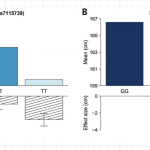Evolution of Diet
Years ago I proposed a theory (not anywhere in print, just in seminars and talks) that went roughly like this. Humans hunt. Dogs hunt. Prey animals get hunted. Each species (or set of species) has a number of characteristics such as the ability to stalk, track, kill, run away, form herds, etc. Now imagine a landscape with humans, wolves, and game animals all carrying out these behaviors, facilitated with various physical traits. Then, go back to the drawing board and redesign the system.
The hunting abilities of humans and dogs, the tendency of game animals to herd up or take other…
A few days ago the UN agency in charge of keeping track of cancer risks listed meat and processed meats as to some degree or another likely to cause an increase in cancer risks. I wrote about that here. More recently. I was interviewed by Joshua Holland on the Politics and Reality Radio show about that story. Here is the interview for your listening pleasure:
There is a new paper in Science linking genetic variation in people living in Greenland with long term selection for managing a marine-oriented diet, affecting stature, weight, and probably, physiological processing of omega-3 polyunsaturated fatty acids (PUFAs).
The vast majority of the variation we seen in stature (height) among humans is not genetic. That is a fact hard to swallow by so many of us who were told in biology class that "height is a complex genetic trait with many genes affecting it." It also seems wrong because the classic examples of variation in stature, the Pygmies of…
I'm thinking it will be the food you eat that gets you. Here's why.
Humans eat a wide variety of foods; as a species, the diversity of species we eat is greater than any other animal by a very large margin, with the only quirky exception being the animals that we take along with us, the commensals such as rats and cockroaches. Most primates eat a high diversity of foods, but about two million years ago or a bit less, according to the “Cooking Hypothesis” (which a lot of people think is correct) we took an already diverse primate diet and added to it anything we might encounter in the…
Catching Fire is apparently a very popular book and/or movie that everyone is very excited about. But Catching Fire: How Cooking Made Us Human is a different a book about some interesting research I was involved in about the origin of our genus, Homo.
You can pick up a copy of our paper on this page. We call it "The Cooking Hypothesis." The basic idea can be summarized with these points:
1) Cooking food transformed human ecology. Many potential foods in the environment can't be consumed by humans (or apes in general) without cooking. But adding cooking to our species-specific technology,…
My friend and colleague Emily Cassidy gave this TED talk! Her research is some of the most important work being done. Have a look:
A recent paper provides the groundwork to establish a way for exercise to diminish appetite. Or, more likely, for sedentary behavior to increase appetite.
It is well known that exercise burns calories. Personally, I think that's overrated: Strength building raises your metabolic demand, and THAT burns calories. But that is not the main topic at hand. New research indicates that exercise also increases the sensitivity of neurons that are related to the control of the feeling of satiation. Therefore, you feel full rather than hungry sooner and/or more often.
In rodents. So far.
The…
I had mentioned earlier that the volcanoes of the Virugna region in the Western Rift Valley (as well as other highland spots) have often been islands of rain forest separated from each other by different habitats, including grasslands and wooded savannas. this has produced an island effect that has been a laboratory for evolution, and it is likely that these forest islands (and others in the greater region of east Central Africa and western East Africa) have been the loci of evolution of many endemic species. (See Island Africa: The Evolution of Africa's Rare Animals and Plants by Kingdon…
The Aquatic Ape Theory is being discussed over at Pharyngula. As PZ points out, an excellent resource on this idea is Moore's site on the topic. Here, I just want to make a few remarks about it.
The Aquatic Ape Theory (AAT) is a human evolution Theory of Everything (TOE) and thus explains, as it should, everything. That is a dangerous way for a theory to act, because if it tries to explain everything then it is going to be wrong in a number of places, and it is going to seem (or even be) right in a number of places but only by chance. (Unless, of course, the TOE is totally rad and really…
... and made a real mess of the place when one of them spotted the jar of pickles on the counter. They fought over it until one of them had almost all the pickles and the other one had a number of bruises and a tiny fragment of one pickle that the other chimp dropped by accident.
That would be the way it would happen if two chimps walked into a bar. Or imagine two chimps, and each finds a nice juicy bit of fruit out in the forest. And instead of eating the fruit, because they are not hungry, they carry it around for a while (this would never happen, but pretend) and then accidentally run…
Or not.
Much is made of the early use of stone tools by human ancestors. Darwin saw the freeing of the hands ad co-evolving with the use of the hands to make and use tools which co-evolved with the big brain. And that would make the initial appearance of stone tools in the archaeological record a great and momentous thing. However, things did not work out that way.
It turns out that up-rightedness (bipedalism), which would free the hands, evolved in our ancestors a very long time (millions of years) prior to our first record of stone tools. The earliest upright hominids that are…
One of the most interesting and exciting stories in science is that of the Younger Dryas. The Younger Dryas was a climate event that had important effects on human history, and that has been reasonably linked to some of our most important cultural changes, and ultimately some evolutionary changes as well. That is one reason why it is interesting. In addition, the Younger Dryas was a pretty big deal ... a climate change or something like a climate change that caused massive changes all around the earth, and fairly recently. But the cause of the Younger Dryas is at present unknown, although…
Stephen Jay Gould and David Pilbeam wrote a paper in 1974 that was shown ten years later to be so totally wrong in its conclusions that it has fallen into an obscurity not usually linked to either Gould or Pilbeam. However, they were actually right in ways that they could not have anticipated. And even if they were not right, this paper still has much to contribute, including the opening words of that publication in Science, which are very much worthy of consideration for many reasons:
It is no longer true that there are more practitioners than pieces. In fact, when I encountered this…
Fallback foods are the foods that an organism eats when it can't find the good stuff. It has been suggested that adaptive changes in fallback food strategies can leave a more distinct mark on the morphology of an organism, including in the fossil record, than changes in preferred food strategies. This assertion is based on work done by the Grants and others with Galapagos Island finches, by Richard Wrangham and me with hominids, and by Betsy Burr and me with rodents.
The reason for this is simple. There is a rough correspondence between how much energy one can obtain from a food type and…
Evolution: The Mind's Big Bang
I've known Shea for years ... since before grad school. Going out drinking with this guy was a little dangerous. Almost as dangerous as going out drinking with me.
From Scientific American, a piece on the "Cooking Hypothesis" (which yours truly helped develop some years back).
Our hominid ancestors could never have eaten enough raw food to support our large, calorie-hungry brains, Richard Wrangham claims. The secret to our evolution, he says, is cooking
Cooking does indeed turn a lot of stuff that is not edible to humans (or any primate) into usable energy. We think the increase in body size that comes along with the genus Homo (with Homo erectus and kin) is itself a biological signal of cooking.
The problem with his idea: proof is slim that any…
Birds evolved during the Mesozoic, during the various "Ages" of the dinosaurs, as a subset of those dinosaurs. Many researchers believe that these early birds were different from their then very close dinosaur cousins because of their flight adaptations, and some have linked this idea to flight-based or tree- based foraging.
Today, most birds fly (counting by species) and their flight is linked to their primary dietary adaptation. Some birds actually feed on the wing, while others fly to food sites and once there do not locomote very much. Other birds forage on the ground habitually. The…
Many years ago a couple of researchers (Hatley and Kappleman) suggested omnivory, including eating of roots, to be a common theme in the adaptations we see in bears, humans, and pigs. Some years later, Richard Wrangham and I independently and for different reasons came to the idea that roots are potentially important in human evolution, so we collaborated on a paper suggesting this. Subsequently, bits and pieces of data have been accumulating to support this hypothesis (the "root hypothesis"). And here, Jim Moore of San Diego, is reporting on living chimps eating roots in a relatively…
I find it absolutely fascinating that scientists often bother to estimate the effects of diet by feeding controlled quantities of food, especially plant food, to rats to see what happens.
For example, there is a common substance in cooked food that, if fed in even modest quantity to rats, causes the rats to get cancer and die in no time. This raises concerns for humans because, well, the rats died. So the substance must be "bad for you."
But this approach to nutritional science, and the reasoning that goes with it, is deeply flawed.
Now, you may wish to jump in and say, "No, wait,…




